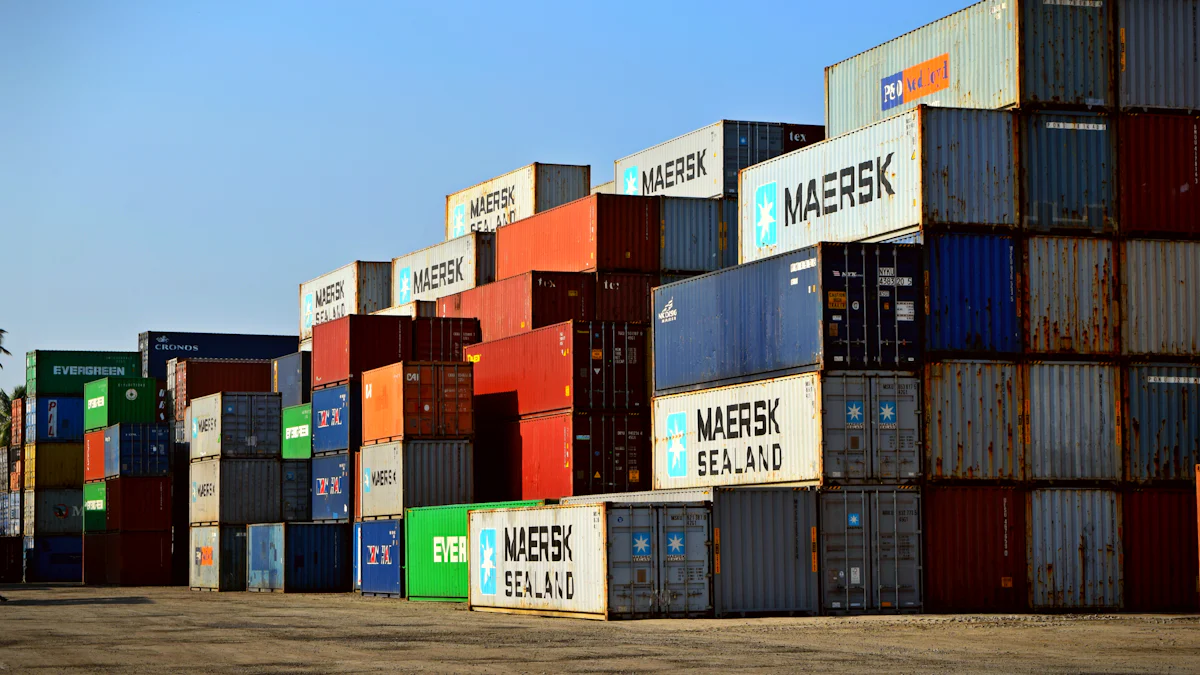How to Mitigate Supply Chain Risks Effectively in 2025

Supply chains in 2025 face unprecedented challenges, demanding a proactive approach to risk management. Organizations that anticipate and address vulnerabilities can recover swiftly from disruptions, ensuring business continuity and customer satisfaction. This builds trust and positions them as reliable partners in the market. Research highlights that companies practicing proactive risk management spend 50% less on managing supplier disruptions, showcasing its cost-effectiveness. Additionally, 60% of global organizations expect robotic process automation to transform supply chains by 2025, underscoring the need for adaptability. Addressing supply chain risk is no longer optional; it is essential for resilience and sustained growth.
Understanding Supply Chain Risks in 2025
Defining Supply Chain Risk and Its Impact
Supply chain risk refers to potential disruptions or vulnerabilities that can affect the flow of goods, services, and information within a supply chain. These risks can arise from various sources, including geopolitical tensions, economic instability, and technological failures. In 2025, the interconnected nature of global supply chains amplifies the impact of these risks. A single disruption can cascade across multiple tiers, leading to delays, increased costs, and reputational damage. For businesses, failing to address these risks can result in lost revenue and diminished customer trust.
Why Risk Management Is Critical in 2025
Risk management has become indispensable in 2025 due to the growing complexity of global trade and the rise of emerging supply chain risks. Frequent cybersecurity threats, drastic climate changes, and evolving regulatory landscapes demand robust governance. Economic instability, marked by inflation and market volatility, further complicates operations. Companies that prioritize risk management can navigate these challenges effectively, ensuring operational continuity and competitive advantage. Ignoring these risks can lead to severe financial losses and operational inefficiencies.
Key Categories of Supply Chain Risks
Geopolitical and Economic Risks
Geopolitical tensions and economic uncertainty remain significant challenges. Trade disruptions caused by political instability, regulatory changes, and inflationary pressures can hinder global trade. For instance, Brexit and other trade agreements continue to reshape supply chain dynamics, requiring businesses to adapt swiftly.
Technological and Cybersecurity Risks
The increasing reliance on interconnected systems exposes supply chains to cyber risks. Data breaches and system disruptions can halt operations and compromise sensitive information. Technological disruptions, such as system failures or outdated infrastructure, further exacerbate vulnerabilities.
Environmental and Climate-Related Risks
Extreme weather events, including floods, hurricanes, and droughts, disrupt supply chain operations. These events affect raw material sourcing, manufacturing, and transportation. Companies must adopt resilient strategies to mitigate these risks and ensure sustainability.
Operational and Supplier Risks
Operational risks stem from inefficiencies within the supply chain, such as labor shortages or production delays. Supplier risks, including dependency on single-source suppliers or quality issues, can disrupt the entire supply chain. Diversifying suppliers and improving collaboration can help mitigate these risks.
Emerging Risks and Challenges in 2025

Geopolitical Tensions and Trade Disruptions
Geopolitical tensions continue to reshape global supply chains in 2025. Ongoing conflicts, such as the war in Ukraine, and strained relations between major economies like the U.S. and China, have led to unpredictable trade routes and increased costs. Political instability, trade sanctions, and shifting regulatory policies disrupt supply chain networks, forcing companies to adapt quickly. For instance, tariffs and sanctions have delayed shipments and raised operational expenses. Businesses must adopt strategies like sourcing diversification and localized production to mitigate supply chain risks caused by these disruptions. Effective risk management ensures resilience against these geopolitical challenges.
Technological Disruptions and Cybersecurity Threats
The rapid adoption of digital technologies has introduced new risks to supply chain management. Cybersecurity threats have surged by 43% year-on-year, posing significant challenges to operational continuity. Ransomware attacks on ports or logistics companies can halt operations, leading to severe supply chain disruptions. Additionally, technological failures, often stemming from insufficient testing of new systems, can delay critical shipments. Companies must prioritize robust testing, implement fail-safes, and invest in advanced cybersecurity measures to safeguard their operations. Scenario planning and contingency plans are essential for mitigating supply chain risk in this digital era.
Climate Change and Environmental Challenges
Climate change has emerged as a critical factor influencing supply chain risks. Extreme weather events, such as hurricanes, floods, and droughts, disrupt transportation and manufacturing processes. These environmental challenges increase operational risks and demand sustainable practices. Companies must integrate sustainability into their supply chain strategies to address these risks effectively. Strategic risks related to climate change require proactive crisis management and long-term planning. By adopting eco-friendly practices and enhancing resilience, businesses can navigate these emerging supply chain risks while meeting consumer expectations for sustainability.
Shifting Consumer Expectations and Market Trends
Consumer expectations in 2025 are reshaping supply chain operations. Businesses must adapt to meet these evolving demands, which influence purchasing decisions and brand loyalty. Companies that fail to address these shifts risk losing market share and customer trust.
Key trends driving consumer expectations include:
Faster delivery times, with customers expecting same-day or next-day shipping.
A growing preference for personalized products and services.
Increased emphasis on ethical sourcing and sustainability.
The integration of advanced technologies like artificial intelligence, blockchain, and data analytics is transforming supply chains to meet these demands. These tools enhance transparency, improve efficiency, and enable businesses to respond quickly to changing consumer needs. For example, blockchain ensures traceability in sourcing, addressing the rising demand for ethically produced goods.
Sustainability has become a critical factor in consumer decision-making. Recent studies reveal that 85% of consumers are aware of climate change's impact and are willing to pay nearly 10% more for sustainably sourced products. This shift compels businesses to adopt eco-friendly practices and prioritize green logistics. Companies that integrate sustainability into their supply chain strategies not only reduce environmental risks but also gain a competitive edge.
Customization is another significant trend. Consumers increasingly seek tailored products that reflect their preferences. Businesses must leverage data analytics and flexible manufacturing processes to deliver personalized solutions. Meeting these expectations requires agility and innovation across the supply chain.
Adapting to these trends is essential for mitigating supply chain risk. Companies that embrace technology, sustainability, and customization will thrive in this dynamic landscape, ensuring resilience and customer satisfaction.
Identifying and Assessing Supply Chain Risks
Conducting Comprehensive Risk Assessments
Conducting a thorough risk assessment is essential for effective supply chain risk management. Businesses must map their supply chains to identify vulnerable entities and critical nodes. This visualization helps prioritize areas requiring immediate attention. For example, mapping can reveal dependencies on single-source suppliers, which increases exposure to disruptions. Companies should also assess supplier risks by evaluating their reliability, reputation, and disaster preparedness.
Additionally, organizations should implement logistics contingency plans and conduct internal training to foster a risk-aware culture. Consistent monitoring of supply chain risk factors ensures early identification of potential issues, enabling businesses to respond proactively.
Leveraging Supply Chain Visibility and Transparency with JusLink
Supply chain visibility and transparency are critical for mitigating risks in 2025. JusLink, JUSDA's intelligent supply chain platform, offers real-time insights into logistics and inventory. Its Control Tower Intelligent Risk Management system integrates external data to monitor risks and provide timely alerts. This capability allows businesses to address disruptions before they escalate.
JusLink enhances supply chain visibility and transparency by offering tools like AI-driven forecasting and automated application management. These features enable companies to track shipments, detect anomalies, and optimize inventory levels. For instance, JusLink's real-time monitoring ensures that businesses can adapt quickly to geopolitical or environmental disruptions. By leveraging JusLink, companies can develop effective mitigation strategies and maintain operational continuity.
Using Predictive Analytics and AI for Risk Forecasting
Predictive analytics and AI have revolutionized risk forecasting in supply chain management. These technologies analyze data from various sources, such as supplier reliability and geopolitical events, to identify potential disruptions. For example, a global electronics manufacturer can use predictive analytics to foresee supply chain risks caused by political instability and prepare contingency plans.
Key benefits of predictive analytics include:
Identifying risks before they materialize, enabling proactive responses.
Developing contingency plans to avoid costly delays.
Enhancing decision-making through data-driven insights.
AI-powered tools like JusLink's intelligent risk management system provide real-time alerts and predictive capabilities. These tools empower businesses to implement scenario planning and create contingency plans, ensuring resilience against unforeseen challenges.
Collaborating with Suppliers for Risk Awareness
Collaborating with suppliers plays a vital role in mitigating supply chain risk. Strong partnerships foster open communication, enabling businesses and suppliers to share critical information and address potential vulnerabilities. This proactive approach enhances visibility across the supply chain, allowing organizations to anticipate and resolve risks before they escalate.
Supplier collaboration ensures better continuity of supply. When suppliers have access to accurate demand forecasts and operational insights, they can plan more effectively for the future. This reduces the likelihood of disruptions caused by market competition or cash flow challenges. Additionally, suppliers gain a clearer understanding of their market share and growth opportunities, which strengthens their ability to manage risks.
Joint problem-solving is another significant benefit of supplier collaboration. By pooling resources and expertise, companies and their partners can develop robust contingency plans and improve overall resilience. For example, a collaborative supply chain can identify potential bottlenecks and implement solutions to prevent delays. This approach not only minimizes risks but also enhances operational efficiency.
Building strong supplier relationships requires consistent communication and mutual trust. Businesses should engage suppliers in regular risk assessments and strategy discussions. This collaborative effort ensures that all stakeholders remain aligned and prepared to address challenges. By fostering these partnerships, organizations can create a resilient supply chain capable of withstanding uncertainties.
Actionable Strategies for Building Resilient Supply Chains

Diversifying Suppliers and Sourcing Locations
Diversifying suppliers and sourcing locations is a critical strategy for mitigating risk in supply chain management. Relying on a single supplier or region increases vulnerability to disruptions caused by geopolitical instability, natural disasters, or economic downturns. By diversifying, companies can:
Avoid risks associated with political and economic instability in any one region.
Adapt swiftly to market changes and manage interruptions effectively.
Enhance flexibility and agility, enabling quick adjustments to fluctuating demand.
Leverage competition among multiple suppliers to secure better pricing and manage costs.
Reduce disruptions and increase resilience to unpredictable demand or supply shortages.
Combining supplier diversification with advanced inventory management and technology adoption further strengthens operational efficiency. This approach ensures businesses remain agile and prepared for unforeseen challenges.
Strengthening Supplier Relationships with JUSDA’s Solutions
Strong supplier relationships are essential for building resilient supply chains. JUSDA’s innovative solutions, such as the Supply Chain Management Collaboration Platform, foster collaboration and transparency. These tools enable businesses to share real-time data with suppliers, improving communication and joint problem-solving. For example, JUSDA’s platform integrates demand forecasting and delivery schedule coordination, ensuring suppliers can plan effectively and meet expectations.

JUSDA Solutions
To provide you with professional solutions and quotations.
By leveraging JUSDA’s solutions, companies can enhance supplier trust, reduce risks, and improve overall supply chain performance. This strategic partnership approach ensures continuity and resilience in the face of disruptions.
Investing in Technology for Supply Chain Risk Management
Blockchain for Enhanced Transparency
Blockchain technology offers unparalleled transparency in supply chain management. It creates an immutable record of transactions, enabling businesses to trace goods from origin to delivery. This transparency reduces fraud, ensures ethical sourcing, and enhances trust among stakeholders. For instance, blockchain can verify the authenticity of raw materials, addressing consumer demands for sustainability and ethical practices.
IoT for Real-Time Monitoring
The Internet of Things (IoT) revolutionizes risk management by providing real-time monitoring of supply chain activities. IoT devices track shipments, monitor environmental conditions, and detect anomalies during transit. These insights allow businesses to respond quickly to potential disruptions, minimizing delays and losses. IoT’s integration with platforms like JusLink enhances visibility and operational efficiency, ensuring seamless supply chain operations.
Emerging technologies like blockchain and IoT empower businesses to identify risks early, enhance transparency, and maintain operational continuity. These tools play a strategic role in building resilient supply chains.
Emphasizing Sustainability and Ethical Practices
Sustainability plays a strategic role in building resilient supply chains. It enhances adaptability, reduces costs, and aligns operations with environmental and societal goals. Companies that prioritize sustainability not only mitigate risks but also gain a competitive edge in the market.
Aspect | |
|---|---|
Enhanced Processes | Improves efficiency and adaptability |
Reduced Costs | Lowers operational expenses |
Increased Productivity | Boosts overall output and effectiveness |
Improved Societal Outcomes | Aligns with community and environmental goals |
Sustainability increases visibility across the supply chain, enabling businesses to monitor operations and respond to changes effectively. It also enhances agility, allowing companies to adapt quickly to disruptions. By adopting eco-friendly practices, businesses protect against environmental risks and meet consumer expectations for ethical sourcing.
Key practices for emphasizing sustainability include:
Reducing carbon emissions through green logistics and energy-efficient transportation.
Sourcing materials responsibly to ensure ethical practices.
Implementing circular economy principles, such as recycling and waste reduction.
These practices not only improve supply chain resilience but also contribute to long-term profitability. Companies that integrate sustainability into their operations demonstrate a commitment to societal well-being, fostering trust among stakeholders. This approach ensures that businesses remain competitive while addressing global challenges.
The Role of Continuous Monitoring and Adaptation
Establishing KPIs for Supply Chain Risk Management
Key performance indicators (KPIs) serve as essential tools for evaluating and improving risk management efforts. They provide measurable insights into the effectiveness of strategies and highlight areas requiring attention. Organizations in 2025 should prioritize the following KPIs to monitor supply chain risk effectively:
Mean Time to Recovery (MTTR): Tracks the average time needed to recover from disruptions. A lower MTTR reflects a more resilient supply chain.
Supply Chain Visibility: Measures the ability to track and monitor activities across the supply chain. High visibility ensures early detection of risks.
On-time In Full (OTIF) Delivery Rate: Indicates the percentage of orders delivered on time and in full, reflecting operational efficiency.
By leveraging these KPIs, businesses can maintain continuous monitoring and adapt their operations to mitigate risks effectively.
Regularly Reviewing and Updating Mitigation Strategies
Risk management strategies must evolve to address emerging challenges. Regular reviews ensure that businesses remain prepared for disruptions. Most organizations benefit from annual evaluations, but industries with higher risks or rapid changes should consider quarterly or semi-annual reviews. A risk-based approach, prioritizing high-likelihood and high-severity risks, optimizes review frequency.
Frequent updates to mitigation strategies allow companies to adapt to shifting conditions. For example, geopolitical tensions or new regulatory requirements may necessitate immediate adjustments. Businesses that proactively refine their strategies can minimize disruptions and maintain operational continuity.
Staying Informed About Global Trends and Events
Staying informed about global trends is critical for effective risk management. In 2025, several trends significantly impact supply chain operations:
Trade restrictions and geopolitical tensions, particularly between major economies, increase costs and disrupt supply chains.
Cyber threats targeting digitized supply chains demand heightened security measures.
Climate change considerations influence risk management strategies, requiring sustainable practices.
Economic instability, including inflation and currency fluctuations, challenges operational planning.
Organizations must adopt continuous monitoring of these trends to anticipate risks and implement timely responses. Strategies like dual-sourcing, supply chain decentralization, and leveraging technology for real-time monitoring enhance resilience. By staying informed, businesses can align their operations with global developments and maintain a competitive edge.
Fostering a Culture of Agility and Resilience
Fostering a culture of agility and resilience equips organizations to navigate the complexities of modern supply chains. Agility enables businesses to adapt swiftly to disruptions and market shifts, ensuring operational continuity. Resilience, on the other hand, strengthens the ability to recover from setbacks while maintaining customer satisfaction.
Organizations that prioritize agility benefit from enhanced adaptability. Flexible manufacturing processes and real-time data analytics allow businesses to respond quickly to changing market conditions. This approach emphasizes responsiveness over traditional efficiency-focused methods, enabling companies to meet evolving customer demands without compromising quality. For example, agile supply chains can adjust production schedules or reroute shipments during unforeseen disruptions, minimizing delays and losses.
Proactive risk management remains a cornerstone for addressing supply chain risk in 2025. Businesses that adopt this approach benefit from significant cost savings, faster recovery from disruptions, and compliance with global regulations. Tools like JusLink empower organizations to mitigate supply chain risks effectively, ensuring operational continuity and customer satisfaction.
Building supply chain resilience fosters innovation by transforming challenges into opportunities. Resilient supply chains enhance customer experiences, drive business growth, and position companies as industry leaders. Organizations that prioritize these strategies not only minimize disruptions but also unlock pathways to long-term success.
See Also
Address Supply Chain Risks To Safeguard Your Business
Adopting Sustainable Strategies For Supply Chain Risk Management
Understanding Risks To Strengthen Your Supply Chain Security
Navigating Supply Chain Risks: A Comprehensive Management Guide
Stay Ready: JUSDA Strategies For Robust Supply Chain Management
